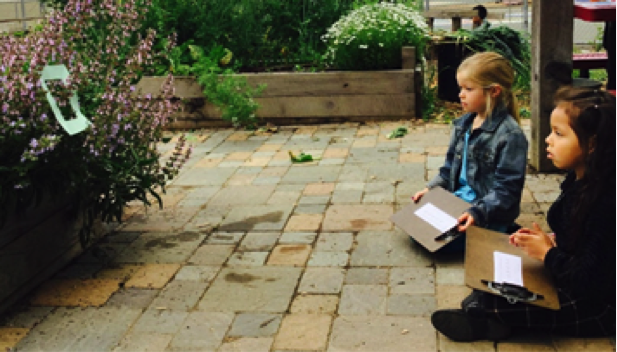Ethos of Citizen Science
By Jen Metes
 As someone who’s always maintained a
fondness for campy antics, not to mention built a strong personal
identity as an environmental educator, two of my favorite tag
lines are, ‘The more you look, the more you see!’ and
‘Change is the only constant!’ I’ve used these
phrases way too many times with students and throughout my life
in general; yet here I am, revisiting their meanings once
again. These simple themes help formulate my thinking about
the ethos of citizen science.
As someone who’s always maintained a
fondness for campy antics, not to mention built a strong personal
identity as an environmental educator, two of my favorite tag
lines are, ‘The more you look, the more you see!’ and
‘Change is the only constant!’ I’ve used these
phrases way too many times with students and throughout my life
in general; yet here I am, revisiting their meanings once
again. These simple themes help formulate my thinking about
the ethos of citizen science.
Information Saturation
Society now exists and operates within a realm of ever-changing technology, relentless data download, and fast-paced knowledge acquisition. We have the capability of acquiring vast quantities of information at the click of a button, yet we need lots of people out there — of any age — actually collecting that info in order to make the best use of it.
Let’s think about the natural landscapes around us for example. In this day and age, when it comes to our environments there is a need to think BIG—across extensive geographic ranges and over periods of time spanning months, years, decades, and centuries. Long-term ecological monitoring happening throughout these vast spatial-temporal boundaries can track seemingly trivial details—the week a single plant leafs out, or the amount of rain that fell on a certain day, or an unassuming beetle spotted in a particular place. Yet these individual observations collectively shed light on trends that might otherwise remain unknown. The more you look, the more you really DO see! And with a world population of 7 billion and counting, there are plenty of pairs of eyes out there that can be looking—recording observations that contribute to robust scientific datasets and greater overall knowledge of our world. These everyday observations may be the key to understanding large-scale change.
Ch-ch-ch-ch-Changes!
We’ve entered an era of alarmingly rapid environmental change. While dramatic change to the landscape was once fought tooth and nail through resistant management strategies such as fire suppression and aggressive flood control, many ecologists and resource managers now embrace resilience thinking, which focuses on adapting to and withstanding disturbances, to avoid irreversible changes to a system.
Endangered species are examples of alarming change occurring in natural environments. In the past and largely still today, conservation science focuses large amounts of time and money on attempting to rescue many species from near extinction. However, this strategy is a last ditch effort and a sign that we have already failed maintaining a healthy plant or animal population. Therefore, emerging management strategies recognize the need to actively keep species OFF the endangered list through on-going monitoring, or, keeping a pulse on what might constitute subtle signals of concern before a species is pushed to the brink. To understand the health of species populations in this way, there is a need for, you guessed it! …. MORE looking and MORE seeing, carried out by MORE people than just biologists and other science professionals. These monitoring contributions may include adding observations to park species lists, documenting bird migrations in a wetland, even collecting critter poop out in remote wilderness! This long-term monitoring helps track the vital signs of a population, and if even slight changes are detected, communities will be able to react with management solutions before it’s too late.
Science is merely one way of knowing about the world
While citizen science may not be a panacea to every research question or environmental problem, it has the capacity to expand science as we currently understand it by incredible margins. We are just catching a glimpse of citizen science’s potential, which is hard to do because it requires us to acknowledge the capabilities of a diverse global society rather than a select group of science professionals. We can no longer formulate what we understand through the lens of a single field. In order to successfully discover and disseminate relevant information in our modern day world, we must interpret challenges through multiple ways of knowing. Our capacity for technology and knowledge far exceed the threshold of institutional science. Therein lies the need for recognizing the untapped possibility of citizen science. Because let’s face it, change IS the only constant…and the only way to perceive that change is to get more people looking for it.
Jen Metes is finishing up her Masters in Community Development, and has worked on both our Youth and Coastal Citizen Science projects









